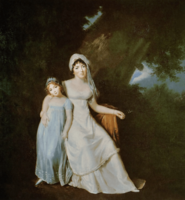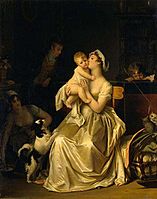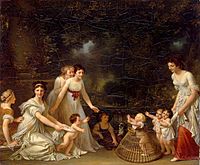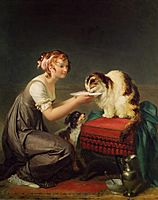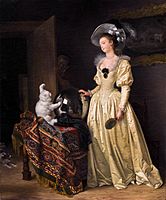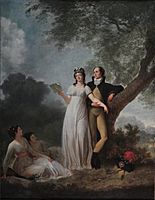Marguerite Gérard facts for kids
Quick facts for kids
Marguerite Gérard
|
|
|---|---|
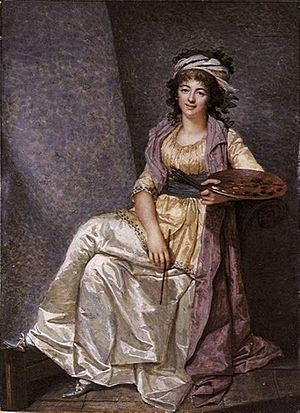
Marguerite Gérard, by François Dumont
|
|
| Born | 28 January 1761 |
| Died | 18 May 1837 (aged 76) Paris, Kingdom of France
|
| Nationality | French |
| Known for | painting, etching |
| Style | Genre art |
Marguerite Gérard (born January 28, 1761, in Grasse; died May 18, 1837, in Paris) was a very successful French artist. She was known for her paintings and prints in the Rococo style.
Marguerite was the daughter of Claude Gérard, who made perfumes. When she was 14, she went to live with her sister and her sister's husband, Jean-Honoré Fragonard. He was a famous painter. Marguerite became his student in the mid-1770s. She learned painting, drawing, and printmaking from him.
Marguerite Gérard created more than 300 paintings of everyday life. She also painted 80 portraits and many small miniature artworks. One of her paintings, The Clemency of Napoleon, was bought by Napoleon himself in 1808.
Contents
Marguerite Gérard's Life Story
When Marguerite's mother passed away in 1775, Marguerite was the youngest of seven children. She moved to the Louvre in Paris. She lived there with her sister and her brother-in-law, Jean-Honoré Fragonard. She stayed there for about 30 years. This allowed her to see many amazing artworks every day.
By 1785, Marguerite was known as a talented painter of everyday scenes. She was the first French woman to achieve this. She was especially interested in the "genre scenes" painted by Dutch Golden Age artists. She often copied their style in her own work.
Marguerite was not allowed to join the Royal Academy of Painting and Sculpture. This was because they limited the number of women artists to only four at a time. The Academy also did not offer free art training to women. Women could not compete for the important Prix de Rome award either.
Despite these challenges, she showed her art widely. After the French Revolution, the Salon art exhibition opened to women. She showed her work there between 1799 and 1824. She won several awards, including a gold medal in 1804.
Because she was connected to Fragonard's art group, Marguerite could remain unmarried. She did not have to worry about money. This allowed her to focus on her art career. She was very successful for over 50 years. Marguerite saw Fragonard as a father figure. After he passed away, she continued to live with her sister for 17 more years.
How Marguerite Gérard Created Art
Marguerite became interested in art while living with her sister, Marie-Anne Fragonard, and brother-in-law, Jean-Honoré Fragonard. She wanted to be an artist like her sister, who painted miniatures. Her brother-in-law encouraged her dreams.
She began training with Fragonard when she was 16. She worked from his drawings to create her first pieces. Soon after, she started making her own genre paintings. These paintings showed scenes from everyday life. Her style was very similar to Dutch artists like Gerard Ter Borch and Gabriël Metsu.
Like these Dutch artists, Gérard painted with great detail. She used very smooth brushstrokes. Her paintings were simple but showed an important art trend of the early 1800s. She painted small, everyday moments in the homes of wealthy middle-class people. Marguerite Gérard helped open the way for other women artists. She also influenced male artists of the next generation, including her nephew Alexandre Evariste. She tried to be for him what Fragonard had been for her.
What Marguerite Gérard Painted
As a genre artist, Marguerite Gérard focused on showing private moments of home life. She often used costumes and settings from a few centuries before her own time. This was different from other female painters who used ideas from ancient times.
You can often spot domestic cats and dogs in Gérard's paintings. Many of her artworks show what it's like to be a mother or a child at home. Several paintings also highlight the importance of music and female friendships.
One of her more ambitious prints was The Genius of Franklin (Le Génie de Franklin). This print showed Benjamin Franklin and America as a woman. This artwork helped make Gérard's work known to more people. This was because prints could be easily copied and shared. Gérard also painted at least 35 portraits of painters, actors, and people who supported her art. She created these between 1787 and 1791.
Main Art Exhibitions
Marguerite Gérard showed her work at the Paris Salon many times:
- 1799: four paintings (she won a prize)
- 1801: three paintings (she won an encouragement prize for deux jeunes époux lisant leur correspondence d'amour)
- 1802: three paintings
- 1804: at least seven works (she won a gold medal)
- 1806: three paintings
- 1808: three paintings
- 1810: four paintings
- 1814: seven paintings
- 1817: three paintings
- 1822: four paintings
- 1824: two paintings
Recent Exhibitions
Her work has been shown in modern exhibitions:
- Parfums d'Interdit, Musée Fragonard, Grasse (2018)
- Royalists to Romantics: Women Artists from the Louvre, Versailles, and Other French National Collections, National Museum of Women in the Arts, Washington D.C. (2012)
- Petits théâtres de l'intime, Musée des Augustins, Toulouse (2011–2012)
- Marguerite Gérard, Musée Cognacq-Jay, Paris (2009)
- Trois femmes peintres dans le siècle de Fragonard, Musée de la Parfumerie Fragonard, Grasse (1998)
Gallery
See also
 In Spanish: Marguerite Gérard para niños
In Spanish: Marguerite Gérard para niños




